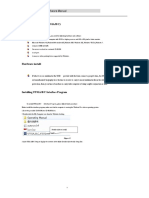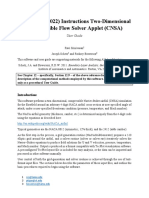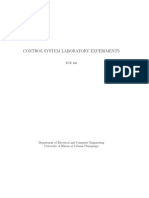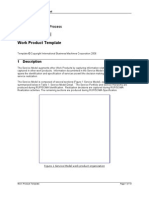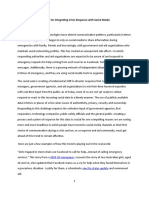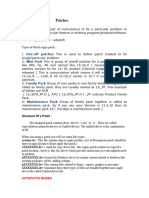ATP Start
ATP Start
Uploaded by
vlady33Copyright:
Available Formats
ATP Start
ATP Start
Uploaded by
vlady33Original Description:
Original Title
Copyright
Available Formats
Share this document
Did you find this document useful?
Is this content inappropriate?
Copyright:
Available Formats
ATP Start
ATP Start
Uploaded by
vlady33Copyright:
Available Formats
B.A.
Mork
Mich Tech Univ
Getting Started with ATP
EE 5220 - Fall Semester 2003
ATP is installed in many/all of the computer labs in the department. The family of programs should be
visible on the Windows desktop in a folder called ATP. If youd like to install it on your home computer,
please apply for a persona license at www.emtp.org (Canadian/American Users Group), and contact your
instructor to borrow an installation CD. It is not legal to copy it onto your home computer without first
signing a license agreement.
In the ATP Program group, there are several options:
ATPDraw: Graphical User Interface for building/editing/running ATP simulations.
ATPDraw Manual in pdf format
PlotXY: Basic very user-friendly plotting program (can paste Win Metafiles from here).
Wsynind: Utility for obtaining parameters for Synchronous and Induction machines.
In general, everything can be done from within the ATPDraw program. Start ATPDraw by doubleclicking on its icon in the ATP program group. Then...
1) Click on the blank sheet symbol to create a new simulation, or click on the file symbol to open an
existing simulation. Edit/Draw the circuit and specify parameters. Use Save-As to save this *.adp
file (or just click on diskette symbol to save changes to existing simulation). The file that the
circuit diagram and parameters are stored in is referred to as a project file. These are kept in
c:\atp\atpdraw\project\*.adp
2) Select ATP | Settings. There are several tabs. The first tab is the most important. There is a HELP
button for each tab. Click on it for an explanation of the required data.
Simulation Tab - Choose reasonable values for Delta T (the integration timestep size) and Tmax
(the length of the simulation). If )t is smaller than needed, the simulation will take longer to run
and youll create huge bloated output files. If )t is too big, this could result in large integration
errors and incorrect results. Make sure that )t is much smaller than the smallest time constant J
and/or the period of the highest frequency. Xopt is zero if you want to specify inductances in units
of mH, or 60 if you want to use Ohms at 60 Hz. Copt is zero if you want to specify capacitances in
units of :F or 60 if you want to use M-Ohms at 60 Hz.
3) To run the simulation and see the results:
a) Select ATP | Run ATP (upper one in the list) - This creates ASCII input data file
c:\atp\atpdraw\atp\*.atp and then runs the simulation. Two output files will be created:
c:\atp\atpdraw\atp\*.lis is a text file containing a log of the simulation (i.e. a record of how the
input file was parsed and interpreted and a record of how the simulation proceeded - this file
can be referred to in case of simulation input errors), and c:\atp\atpdraw\atp\*.pl4 which is a
binary data file containing simulated waveforms.
4) When the simulation is done running, the PlotXY program will automatically come up and it
should automatically load the *.pl4 file that was just created. You can click on LOAD to
manually select the *.pl4 file that you desire to plot. Click on the Voltage or Current waveforms
you wish to plot and the click on PLOT to display them. Experiment with turning the grid off and
on, use the tracking cursor, zoom in by closing a window around the desired part of the waveform,
etc. When you get the plot you want, clicking on COPY puts a Win metafile into clipboard,
allowing you to easily paste the waveform file into a Word or Word Perfect document.
You might also like
- Salesforce Certified Platform App BuilderDocument43 pagesSalesforce Certified Platform App BuildercamillebncrsNo ratings yet
- CASE 84581914 PreviewDocument51 pagesCASE 84581914 PreviewYesenia Gpe Vega100% (1)
- Understanding Computers, Smartphones and the InternetFrom EverandUnderstanding Computers, Smartphones and the InternetRating: 5 out of 5 stars5/5 (1)
- Getting Started With ATP: Folder H:/atp/xxx Does Not Exist. Create?Document2 pagesGetting Started With ATP: Folder H:/atp/xxx Does Not Exist. Create?JosNo ratings yet
- Atp ComtradeDocument8 pagesAtp ComtradeJorge VascoNo ratings yet
- Atp To MathcadDocument8 pagesAtp To MathcadalpcruzNo ratings yet
- ATP Installation GuideDocument12 pagesATP Installation Guidedankoranko100% (1)
- ATPDrawDocument27 pagesATPDrawdbzoNo ratings yet
- SPICE - A Brief Overview-2Document7 pagesSPICE - A Brief Overview-2josuemxNo ratings yet
- Updated OpenFAST User Manual Windows 10Document51 pagesUpdated OpenFAST User Manual Windows 10Mahdi MahnazNo ratings yet
- Manual Data-Streamer V1.3 - Usb and LPT Version: 1) Installing DatastreamerDocument8 pagesManual Data-Streamer V1.3 - Usb and LPT Version: 1) Installing Datastreamerlong rangeNo ratings yet
- Orcad Tutorial ItalianDocument28 pagesOrcad Tutorial ItaliandanyNo ratings yet
- ATPDraw&ATP Installation Guide PDFDocument7 pagesATPDraw&ATP Installation Guide PDFveljal6317No ratings yet
- Ads Circuit SimulationDocument100 pagesAds Circuit Simulationharshasasidharan007No ratings yet
- PSSE Intro Stabilty InstructionsDocument16 pagesPSSE Intro Stabilty InstructionsQuinn RhodesNo ratings yet
- Gmid RuidaDocument7 pagesGmid Ruida謝政谷No ratings yet
- Gmid RuidaDocument7 pagesGmid Ruidapes68No ratings yet
- c3d2OpenSim - TutorialDocument8 pagesc3d2OpenSim - TutorialStefan0% (1)
- Meshing Using SALOME: Original by Otto J Oeleht August 2017Document10 pagesMeshing Using SALOME: Original by Otto J Oeleht August 2017Jhonatan Román RománNo ratings yet
- PSpice InstructionsDocument3 pagesPSpice InstructionsGerhard BetNo ratings yet
- Simulation of IEEE 802.15Document8 pagesSimulation of IEEE 802.15heriedsNo ratings yet
- WinSim ManualDocument13 pagesWinSim ManualDragota MihaiNo ratings yet
- ATPDraw 5 User Manual UpdatesDocument51 pagesATPDraw 5 User Manual UpdatesdoniluzNo ratings yet
- Lab 5: DebuggingDocument12 pagesLab 5: DebuggingSsgn SrinivasaraoNo ratings yet
- UT81A - B - C Computer Interface Software PDFDocument5 pagesUT81A - B - C Computer Interface Software PDFjuanNo ratings yet
- Lab2: Unsigned/Signed Saturating Adder ObjectiveDocument8 pagesLab2: Unsigned/Signed Saturating Adder Objectivea_patiar273No ratings yet
- GTPPLOTDocument38 pagesGTPPLOTjose_jose_jose_89No ratings yet
- 4 Overview of Supporting Programs For Atp-Emtp: 4.1 AtpdrawDocument10 pages4 Overview of Supporting Programs For Atp-Emtp: 4.1 AtpdrawIonutz AxuNo ratings yet
- ATPMAT: An Open Source Toolbox For Systematic Creation of EMTP Cases in ATP Using MatlabDocument6 pagesATPMAT: An Open Source Toolbox For Systematic Creation of EMTP Cases in ATP Using MatlabLalo PatoNo ratings yet
- 1 Atpdraw AtpDocument2 pages1 Atpdraw AtpM Yudi NugrohoNo ratings yet
- Z 80 GettingstartedDocument7 pagesZ 80 GettingstartedResa SatriaNo ratings yet
- ATPDMan 3 R 3Document247 pagesATPDMan 3 R 3Juan Carlos VegaNo ratings yet
- Updated Instructions For CNSA SolverDocument9 pagesUpdated Instructions For CNSA Solvermattcs90No ratings yet
- Tutorial Latihan Eta ModelDocument33 pagesTutorial Latihan Eta ModelRye DeuxNo ratings yet
- Ghid Utilizare DSKDocument6 pagesGhid Utilizare DSKvalivali30No ratings yet
- Z80 Simulator IDE Getting Started PageDocument9 pagesZ80 Simulator IDE Getting Started PageMeggy Novian Dhanar DhonoNo ratings yet
- A Beginner's Guide To MAX+plus II: Quick ReferenceDocument8 pagesA Beginner's Guide To MAX+plus II: Quick ReferenceHemantkumarNo ratings yet
- 2-TX FSK 15-16 Part 1Document8 pages2-TX FSK 15-16 Part 1Đặng Hoài Sơn100% (1)
- Tutorial DHSVM v3.1Document12 pagesTutorial DHSVM v3.1Alekos SanllehiNo ratings yet
- ADS Tutorial: A Beginners Tutorial: Modes of OperationDocument13 pagesADS Tutorial: A Beginners Tutorial: Modes of OperationYounes Ait El MaatiNo ratings yet
- Project #1: Controlling The Tabletop Satellite (Tablesat) Embedded SystemDocument5 pagesProject #1: Controlling The Tabletop Satellite (Tablesat) Embedded SystemmagusoftheguildNo ratings yet
- PCB ManualDocument56 pagesPCB ManualJigar PatelNo ratings yet
- ECE486 Lab ManualDocument106 pagesECE486 Lab ManualDR ARINDAM SENNo ratings yet
- Atmel Programming Cheat SheetDocument2 pagesAtmel Programming Cheat Sheetgulzar ahmedNo ratings yet
- Delite T1 LAB1Document3 pagesDelite T1 LAB1Prabesh ShresthaNo ratings yet
- Control Desk ManualDocument5 pagesControl Desk Manualcristian_chituNo ratings yet
- Speed Up Autocad 2009Document4 pagesSpeed Up Autocad 2009finjan32No ratings yet
- Create Simulate Emulate AtmelDocument8 pagesCreate Simulate Emulate Atmelashwini1512No ratings yet
- Atpdraw As User Shell For Atp SimulationsDocument20 pagesAtpdraw As User Shell For Atp SimulationsIonutz AxuNo ratings yet
- User Manual and Reference For Frame3DDDocument45 pagesUser Manual and Reference For Frame3DDLan Lavisto100% (1)
- Network Setup On Your ComputerDocument3 pagesNetwork Setup On Your ComputerJorge Alberto GonzalezNo ratings yet
- Creating Plasmoids (KDE)Document5 pagesCreating Plasmoids (KDE)mr_sharkNo ratings yet
- ATPDraw Manual 3.5Document247 pagesATPDraw Manual 3.5Renato CapeliniNo ratings yet
- The Mac Terminal Reference and Scripting PrimerFrom EverandThe Mac Terminal Reference and Scripting PrimerRating: 4.5 out of 5 stars4.5/5 (3)
- MATLAB Machine Learning Recipes: A Problem-Solution ApproachFrom EverandMATLAB Machine Learning Recipes: A Problem-Solution ApproachNo ratings yet
- Racket Programming the Fun Way: From Strings to Turing MachinesFrom EverandRacket Programming the Fun Way: From Strings to Turing MachinesNo ratings yet
- DigSilent - Synchronous Generator TechDocument21 pagesDigSilent - Synchronous Generator TechmttfrgNo ratings yet
- Cables AACDocument10 pagesCables AACvlady33No ratings yet
- ETAP Zig-Zag TransformerDocument2 pagesETAP Zig-Zag Transformervlady33No ratings yet
- Expulsion FusesDocument2 pagesExpulsion Fusesvlady33No ratings yet
- Coordination Chart For Kearney Type T Fuse LinksDocument2 pagesCoordination Chart For Kearney Type T Fuse Linksvlady33No ratings yet
- Currents Short CircuitDocument2 pagesCurrents Short Circuitvlady33No ratings yet
- Release Control Fire Alarm Systems: FeaturesDocument9 pagesRelease Control Fire Alarm Systems: FeaturesNabil HassanNo ratings yet
- Printers and Primary MemoryDocument6 pagesPrinters and Primary MemorymohamedNo ratings yet
- Et200x Phase OutDocument2 pagesEt200x Phase OutleowkgNo ratings yet
- A Review On Image Fusion For Data Privacy Using Image Processing TechniquesDocument12 pagesA Review On Image Fusion For Data Privacy Using Image Processing TechniquesSAIKUMAR RNo ratings yet
- ASME Digital Twin Summit Keynote - FinalDocument40 pagesASME Digital Twin Summit Keynote - Finaladamchang7483100% (1)
- 24 Lampu Sorot Taman (PHILIPS)Document2 pages24 Lampu Sorot Taman (PHILIPS)hafinNo ratings yet
- 02 TCAD Laboratory Sentaurus TCAD GBB OLDDocument23 pages02 TCAD Laboratory Sentaurus TCAD GBB OLDarunNo ratings yet
- New Creta BrochureDocument10 pagesNew Creta BrochureSayyed Muhammad MustafahNo ratings yet
- Steering Wheel and ColumnDocument33 pagesSteering Wheel and Columnmebarki aberraoufNo ratings yet
- KPI 3G All Vendor - NewDocument62 pagesKPI 3G All Vendor - NewSyachrul AmriefNo ratings yet
- Bio DataDocument3 pagesBio DataTanmoy BaruaNo ratings yet
- What Is CommunicationDocument4 pagesWhat Is CommunicationKlara Abeja0% (1)
- Service Model TemplateDocument13 pagesService Model TemplatejoseluispintorNo ratings yet
- HVDC Fault Location PresentationDocument66 pagesHVDC Fault Location PresentationAmila Pathirana100% (1)
- Sitrans T enDocument12 pagesSitrans T enmani__kanNo ratings yet
- White Paper: The Case For Integrating Crisis Response With Social MediaDocument31 pagesWhite Paper: The Case For Integrating Crisis Response With Social MediaAmerican Red Cross100% (3)
- Kudankulam Case 1Document2 pagesKudankulam Case 1sumanpsk1No ratings yet
- MDS AutoZone New Store 2326Document23 pagesMDS AutoZone New Store 2326Mahesh BehraniNo ratings yet
- PatchesDocument5 pagesPatchesAsifNo ratings yet
- Creating Stunning Dashboards With QlikView - Sample ChapterDocument18 pagesCreating Stunning Dashboards With QlikView - Sample ChapterPackt PublishingNo ratings yet
- An Automation PCI Allocation Method For eNodeB and Home eNodeB CellDocument4 pagesAn Automation PCI Allocation Method For eNodeB and Home eNodeB CellurfriendlyjoeNo ratings yet
- Containers Primer v2Document1 pageContainers Primer v2ashwathNo ratings yet
- Hawassa UNIVERSITY: Daye CampusDocument15 pagesHawassa UNIVERSITY: Daye CampusDesyilalNo ratings yet
- Hearing Instrument Specialist Instructor CV 410 e 1Document3 pagesHearing Instrument Specialist Instructor CV 410 e 1api-372722633No ratings yet
- CNAV MAN 011.7 (C NaviGator User Manual)Document88 pagesCNAV MAN 011.7 (C NaviGator User Manual)Jyoti katariyaNo ratings yet
- Hospital Information Management SystemDocument13 pagesHospital Information Management SystemSarita yadavNo ratings yet
- NS - 12 Incident ResponseDocument24 pagesNS - 12 Incident ResponseYogaRizwanNo ratings yet
- HUS Getting Started GuideDocument82 pagesHUS Getting Started Guidedxp909No ratings yet
























